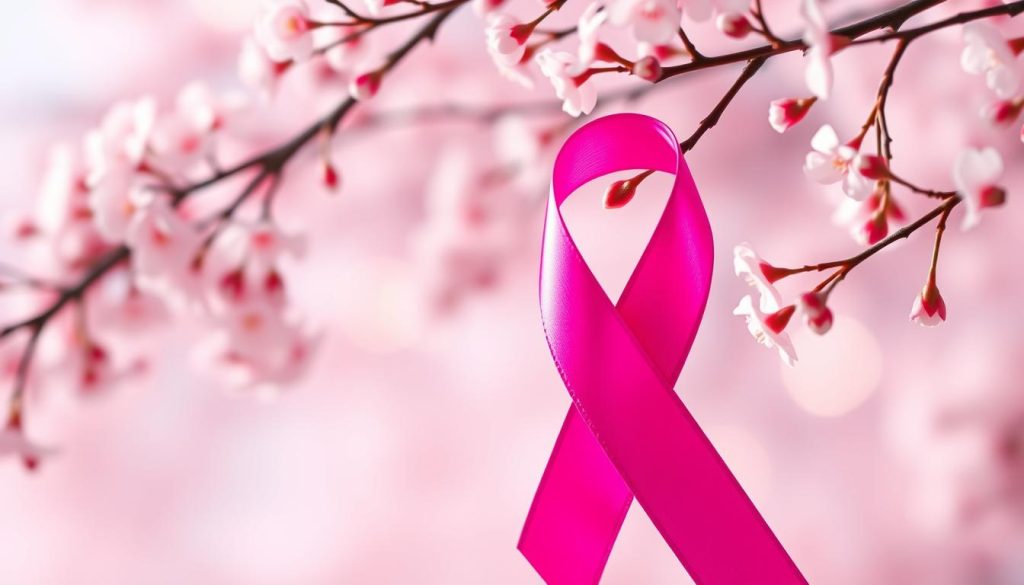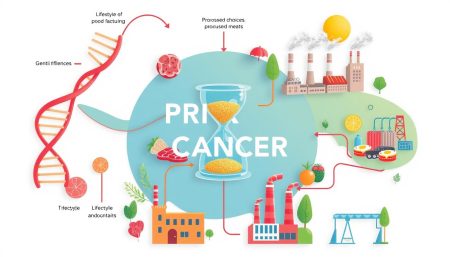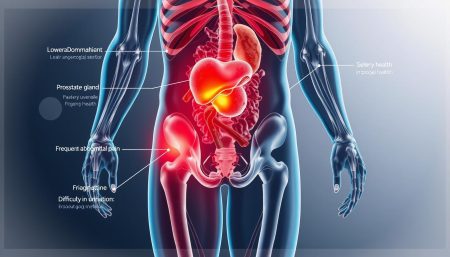October is filled with pink as we come together for Breast Cancer Awareness Month. This campaign highlights a disease that impacts millions globally. It’s a time for communities to support those affected by breast cancer and stress the importance of early detection.
This month, we see a rise in education, fundraising, and advocacy. From local events to worldwide efforts, the goal is clear: to improve outcomes and save lives. Breast Cancer Awareness Month reminds us of the ongoing battle against this disease and the need for regular screenings.
Let’s look at how we can help raise awareness and support those touched by breast cancer. Remember, knowing the facts and catching cancer early can make a huge difference.
Understanding Breast Cancer Awareness Month’s History and Significance
Breast Cancer Awareness Month has become a global movement. It brings together millions to fight this disease. The pink ribbon campaign is at the heart of this movement.
Origins of the Pink Ribbon Movement
In 1992, Evelyn Lauder and Alexandra Penney started the pink ribbon campaign. They gave out pink ribbons at makeup counters. This simple act became a symbol of hope and solidarity for those fighting breast cancer.
Global Impact of Breast Cancer Awareness Month
Breast Cancer Awareness Month started in 1985. It was a partnership between the American Cancer Society and a pharmaceutical company. Today, it’s a worldwide effort, raising millions for research and support.
Evolution of Awareness Campaigns
Over time, Breast Cancer Awareness Month campaigns have changed. Early campaigns focused on raising awareness. Now, they aim to take action, fund research, and support patients and survivors worldwide.
| Year | Campaign Focus | Key Achievement |
|---|---|---|
| 1985 | Initial Awareness | Establishment of Breast Cancer Awareness Month |
| 1992 | Symbol Introduction | Creation of the pink ribbon |
| 2000 | Research Funding | $100 million raised for breast cancer research |
| 2020 | Patient Support | Launch of global virtual support groups |
The pink ribbon campaign keeps evolving. It adapts to new challenges and opportunities in the fight against breast cancer. Every October, Breast Cancer Awareness Month reminds us of our progress and the work ahead.
The Importance of Early Detection and Regular Screening
Early detection saves lives. Breast cancer screening is key to finding cancer early. Regular checkups can greatly improve treatment results and lessen the disease’s impact.
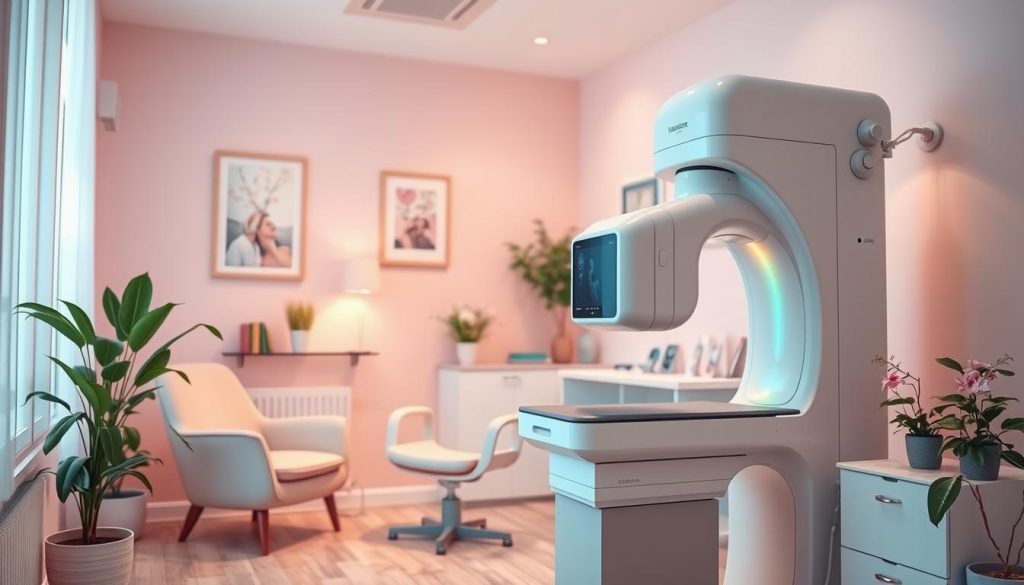
The American Cancer Society suggests annual mammograms for women aged 45 and up. Some might start at 40. Knowing mammogram importance is vital in the fight against breast cancer.
Regular screenings include:
- Mammograms
- Clinical breast exams
- Self-examinations
These methods help monitor breast health. Early detection means more treatment options and a better chance of survival.
| Screening Method | Recommended Frequency | Age Group |
|---|---|---|
| Mammogram | Annually | 45+ (optional 40-44) |
| Clinical Breast Exam | Every 1-3 years | 20-39 |
| Self-Examination | Monthly | All adult women |
By focusing on regular breast cancer screening, women take charge of their health. Early detection through these methods can greatly improve treatment outcomes and survival rates.
Essential Guide to Breast Self-Examination Techniques
Breast self-examination is a key way to find breast cancer early. Knowing how to do it can save lives. This guide will show you how, when, and what to look for during your self-exams.
Step-by-Step Self-Examination Process
Here’s how to do a thorough breast self-examination:
- Stand in front of a mirror with your arms at your sides.
- Raise your arms and look for changes in breast shape or skin texture.
- Lie down and use your right hand to examine your left breast in circular motions.
- Repeat the process for your right breast using your left hand.
- Gently squeeze each nipple to check for discharge.
When and How Often to Perform Checks
Do breast self-exams once a month, 3-5 days after your period. If you don’t have periods, pick a day each month. Being regular helps you know your breasts better and spot changes sooner.
Warning Signs to Watch For
Look out for these signs during your self-exam:
| Visual Changes | Physical Changes |
|---|---|
| Skin dimpling or puckering | Lumps or thickening in breast tissue |
| Nipple inversion or changes | Persistent pain in a specific area |
| Redness or scaliness of skin | Nipple discharge (clear or bloody) |
Remember, self-exams are not a replacement for doctor visits. But they’re a big part of keeping your breasts healthy. If you see anything odd, see your doctor right away. Early detection is key, so make self-exams a regular part of your routine.
Breast Cancer Awareness Month Campaign Initiatives
October is filled with pink as communities come together for Breast Cancer Awareness Month. The pink ribbon symbolizes hope and unity. It sparks action and fuels the fight against breast cancer.
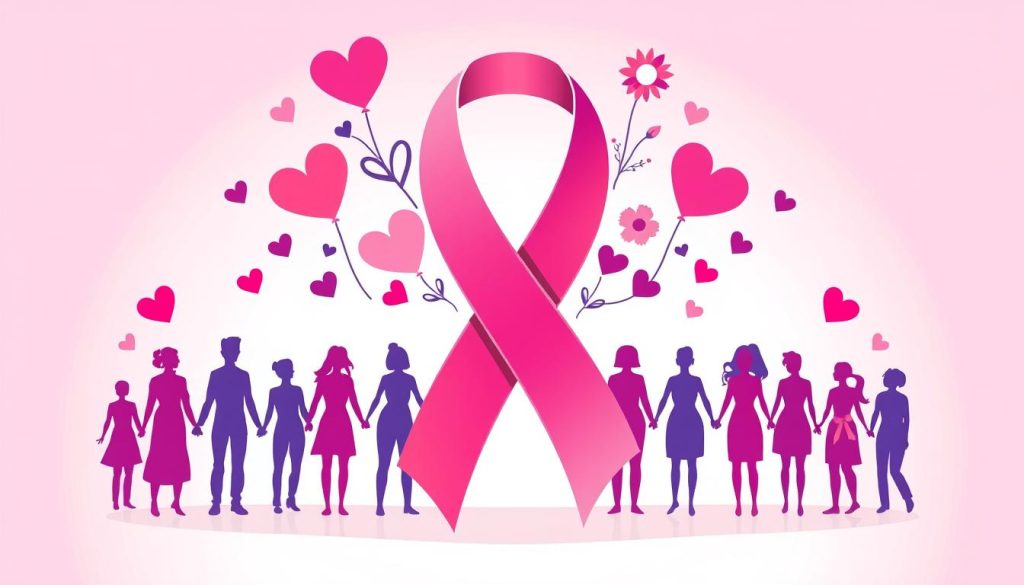
Groups like Susan G. Komen and the National Breast Cancer Foundation lead the way. They host walks, runs, and seminars to raise awareness and funds. These events unite people, creating a strong support network for those touched by breast cancer.
Fundraising events are key in supporting research and patient care. From small bake sales to big galas, they raise essential funds. These funds help finance research, support services, and improve screening access.
Social media campaigns spread the word, reaching millions. Hashtags like #PinkRibbon and #BreastCancerAwareness fill timelines. They start conversations and share knowledge, reaching a wide audience.
Educational efforts are at the heart of awareness. Seminars, workshops, and booths share vital information. They teach about prevention, early detection, and treatment, saving lives and building a more informed community.
The pink ribbon campaign and fundraising events do more than raise money. They build a supportive community, celebrate survivors, and honor those we’ve lost. Through these efforts, Breast Cancer Awareness Month continues to make a difference in the fight against this disease.
Understanding Risk Factors and Prevention Strategies
Knowing about breast cancer risk factors is key to catching it early. By understanding what puts you at risk, you can take steps to stay healthy.
Genetic Risk Factors
Some women are born with genes that raise their breast cancer risk. BRCA1 and BRCA2 are well-known examples. If these genes are in your family, talk to your doctor about getting tested.
Lifestyle-Related Risks
Your daily habits can affect your breast cancer risk. Drinking too much alcohol, being overweight, and not exercising can all increase your risk. Smoking is also a big danger.
Preventive Measures
Regular screening is vital for early detection. Mammograms can find tumors early. Self-exams help you know your body’s normal. Here are ways to lower your risk:
- Stay at a healthy weight
- Exercise regularly
- Limit alcohol intake
- Eat a balanced diet
- Don’t smoke
| Risk Factor | Impact Level | Controllable? |
|---|---|---|
| Genetics | High | No |
| Alcohol Use | Moderate | Yes |
| Obesity | Moderate | Yes |
| Lack of Exercise | Low to Moderate | Yes |
| Smoking | Low to Moderate | Yes |
Having risk factors doesn’t mean you’ll definitely get breast cancer. It just means you should be extra careful. Talk to your doctor about the best plan for you.
Modern Screening Technologies and Mammogram Guidelines
Breast cancer screening has made huge strides. New tech helps find cancer early and accurately. This saves lives and eases worries for many women.
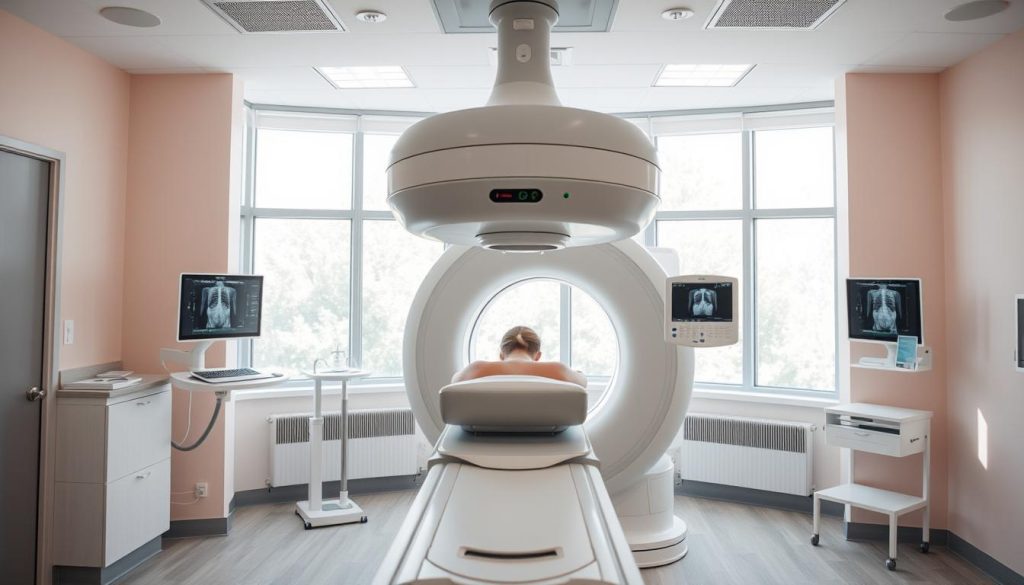
3D mammography is a big leap forward. It takes images from different angles. This helps doctors find small tumors that 2D mammograms might miss. Breast MRI is also powerful. It’s used for high-risk women or when other tests are unclear.
The role of mammograms is vital. They’re the top way to find breast cancer early. Most health groups agree on these guidelines:
- Women 40-44: Can start yearly mammograms
- Women 45-54: Should get mammograms every year
- Women 55 and older: Can switch to every other year or continue yearly
Screening for breast cancer is key for all women. Talk to your doctor about what’s best for you. Regular checks are your best bet for early detection and treatment.
| Screening Method | Benefits | Recommended For |
|---|---|---|
| 2D Mammogram | Standard screening, widely available | All women |
| 3D Mammogram | Better for dense breasts, fewer false positives | Women with dense breasts or high risk |
| Breast MRI | Highly sensitive, no radiation | High-risk women, after inconclusive mammogram |
Supporting the Cause: Ways to Get Involved
Breast cancer awareness month is a time to make a difference. Your support can save lives and bring hope to those fighting this disease. Let’s look at how you can join the fight against breast cancer.
Local Volunteer Opportunities
Volunteering in your area is a great way to help. Hospitals need people to comfort patients and help with office work. You can also join support groups to share your time and kindness with those in need.
Donation Programs
Your donations can fund vital research and support services. Many groups accept money gifts, and you can also give items like wigs or mastectomy bras. Some workplaces match employee donations, doubling your impact.
Community Events
Fundraising events during breast cancer awareness month bring people together. You might join a charity walk, attend a pink-themed party, or take part in a bake sale. These events raise money and spread awareness.
| Event Type | Description | Impact |
|---|---|---|
| Charity Walks | Group walks to raise funds | Builds community, raises awareness |
| Pink Ribbon Sales | Selling ribbons for donations | Visible support, funds research |
| Benefit Concerts | Music events for the cause | Entertains while raising money |
By taking part in these activities, you join a global movement. Your efforts, big or small, contribute to the fight against breast cancer and support those affected by it.
Inspiring Survivor Stories and Personal Journeys
During Breast Cancer Awareness Month, survivor stories light up hope and resilience. These personal journeys inspire those facing similar challenges. They also show the key role of early detection.
Sarah, a 42-year-old mom of two, found a lump during a self-exam. After her diagnosis and treatment, she now pushes for regular screenings. Her story shows the strength of self-awareness and quick medical action.

Michael, a rare male breast cancer survivor, shares his story to raise awareness. He points out that this disease affects men too. His journey highlights the need for inclusive education and support.
Emma, diagnosed at 30, fought her battle with a positive attitude. She credits her recovery to a strong support network and new treatments. Her story encourages others to find community during hard times.
| Survivor | Age at Diagnosis | Key Message |
|---|---|---|
| Sarah | 42 | Importance of self-exams |
| Michael | 55 | Men can get breast cancer too |
| Emma | 30 | Positive attitude aids recovery |
These survivor stories during Breast Cancer Awareness Month show our inner strength. They bring hope, spread awareness, and motivate us to fight breast cancer.
Understanding Metastatic Breast Cancer
Metastatic breast cancer is a big focus during Breast Cancer Awareness Month. It happens when cancer cells spread from the breast to other parts of the body. This stage needs special care and research to help patients.
Treatment Options
Doctors create treatment plans for metastatic breast cancer based on each patient’s needs. They use hormone therapy, targeted drugs, chemotherapy, and immunotherapy. The goal is to slow the cancer’s growth and keep the patient’s quality of life good.
Support Systems
Living with metastatic breast cancer is tough. Support groups, counseling, and patient education programs are key. Family and friends also offer important emotional and practical help.
Latest Research
Scientists are working hard in metastatic breast cancer research. They’re studying personalized medicine, new drug combinations, and immunotherapy. Their goal is to help patients live longer and feel better.
| Research Area | Potential Impact |
|---|---|
| Targeted Therapies | Precise treatment with fewer side effects |
| Immunotherapy | Boosting the body’s natural defenses |
| Liquid Biopsies | Earlier detection of cancer spread |
It’s important to understand metastatic breast cancer for patients and caregivers. With ongoing research and support, there’s always hope for those facing this tough diagnosis.
Pink Ribbon Campaign: Making a Global Impact

The pink ribbon campaign has become a strong symbol for breast cancer awareness. It brings people together from all over the world. It shows that we can fight breast cancer, no matter where we are.
It has made a big difference. It’s not just about wearing a ribbon. It’s about taking action. The campaign has helped fund research, support patients, and raise awareness globally.
In many countries, the pink ribbon has sparked change. It has led to local efforts that meet community needs. From mammogram drives to walks, the campaign fits into different places while keeping its main goal.
- Raises millions for breast cancer research annually
- Encourages regular screenings and early detection
- Provides support networks for patients and survivors
- Educates communities about risk factors and prevention
The pink ribbon campaign’s effect goes beyond October. It keeps the conversation about breast health going all year. This movement saves lives by pushing for early detection and supporting those touched by breast cancer.
The Role of Research and Medical Advancements
Research and medical breakthroughs are changing how we fight breast cancer. New treatments and better tools are helping patients. This shows why screening is key.
Personalized medicine is a big step forward. Doctors can now create treatments just for you. This makes treatments work better and have fewer side effects.
Genetic testing helps find who’s at risk early. This means more screenings for those who need them.
New imaging methods are making screenings better. For example, 3D mammography finds tumors that old methods miss. This proves early detection is life-saving.
Immunotherapy is also showing great promise. It helps your body fight cancer cells better. It’s helped some patients with advanced breast cancer a lot.
- Targeted therapies attack specific cancer proteins
- Liquid biopsies use blood tests to detect cancer DNA
- AI helps radiologists spot tumors more accurately
We need to keep funding breast cancer research. It’s what brings us new treatments and hope. By supporting research, we look forward to more progress in fighting breast cancer.
Supporting Loved Ones Through Their Journey
When someone you care about faces breast cancer, your support can make a big difference. During Breast Cancer Awareness Month, we focus on how to be there for our loved ones. It’s important to offer the right kind of help for their well-being.
Emotional Support Guidelines
Being a good listener is key. Let your loved one share their feelings without judgment. Sometimes, just being present speaks volumes. Remember, it’s okay to not have all the answers. Your genuine care and attention are what matter most.
Practical Assistance Tips
Helping with everyday tasks can ease the burden. Offer to cook meals, do laundry, or drive to appointments. These simple acts can provide immense relief. If you’re unsure what’s needed, ask directly. Your loved one will appreciate your willingness to help.
Communication Strategies
Open, honest talks are key. Ask how they’re feeling and what they need. Avoid saying things like “everything will be fine” as it may not reflect their reality. Instead, express your support and commitment to being there throughout their journey. Sharing survivor stories can offer hope and inspiration during tough times.
FAQ
Q: What is Breast Cancer Awareness Month?
A: Breast Cancer Awareness Month is a global campaign in October. It aims to raise awareness, support research, and encourage early detection of breast cancer. It brings people together worldwide through education, fundraising, and advocacy.
Q: When and how did Breast Cancer Awareness Month originate?
A: It started in 1985, thanks to a partnership between the American Cancer Society and Imperial Chemical Industries. The pink ribbon, introduced in 1992, symbolizes hope and solidarity in the fight against breast cancer.
Q: Why is early detection so important in breast cancer?
A: Early detection greatly improves breast cancer outcomes. It makes the disease more treatable and increases survival rates. Regular screenings, like mammograms, can find cancer early, potentially saving lives.
Q: How often should I get a mammogram?
A: The American Cancer Society suggests annual mammograms for women starting at 45. You can start at 40, but talk to your doctor about your risk factors and the best schedule for you.
Q: How do I perform a breast self-examination?
A: To do a breast self-examination, visually and physically check your breasts for changes. Do it monthly, a few days after your period. Look for size, shape, or color changes and feel for lumps or thickening.
Q: What are some common risk factors for breast cancer?
A: Risk factors include age, genetic mutations, family history, and personal history of breast cancer. Other factors are dense breast tissue, lifestyle choices like alcohol and lack of exercise, and hormone replacement therapy.
Q: What is metastatic breast cancer?
A: Metastatic breast cancer, or Stage IV, spreads beyond the breast to other parts of the body. It’s advanced, but there are treatments to manage symptoms and extend life.
Q: How can I support Breast Cancer Awareness Month?
A: You can support it by joining local events, donating to breast cancer organizations, volunteering, or sharing information on social media. Supporting a friend or family member affected by breast cancer is also important.
Q: What does the pink ribbon symbolize?
A: The pink ribbon symbolizes breast cancer awareness. It stands for hope, support, and the fight against the disease. Wearing a pink ribbon shows solidarity with those affected by breast cancer.
Q: How can I support a loved one diagnosed with breast cancer?
A: Support them by being an emotional and practical help, and by keeping communication open. Listen well, help with daily tasks, and go to appointments with them. Everyone’s needs are different, so ask what they need most.












